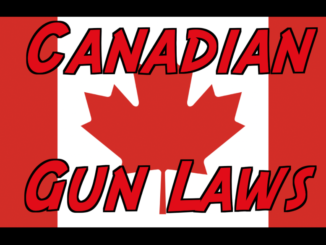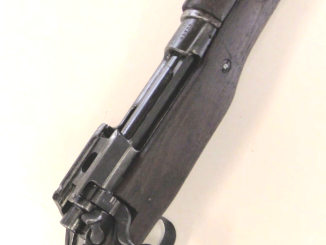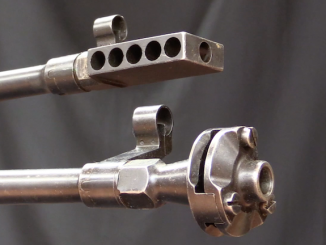Sir Charles Ross was heir to a very wealthy Scottish family, and was a talented if temperamental engineer. He took an interest in firearms and their design, and worked with American and English connections to produce a line of his own straight–pull sporting rifles. Upon returning from the Boer War he looked to expand into the military market.
At this same time, the Canadian government was looking to replenish its arms supplies after the war, and requested Enfield rifles form the British. The request was turned down, as Britain did not have enough supply to spare any form the Canadians. The Canadians were expected to construct their own factory to make rifles oft he standard British pattern. Well, the Canadian government was not eager to invest that sort of capital into the project. They investigated buying arms elsewhere, but the consensus was that Canada’s armaments should come from either Britain or from within Canada itself. No good solution was apparent until Sir Charles Ross stepped in.
Ross offered to fund the construction of a factory himself, and use Canadian labor and industry to manufacture Ross rifles for the military. This seemed like an excellent solution – for zero initial cash outlay, the Canadian government would get rifles both designed and produced domestically! The rifles would be chambered for the standard .303 British cartridge, thus handling the British objections about arms compatibility (Ross pointed out that the British themselves used something like 7 different patterns of rifle at the time).
In 1902, Ross and the Canadian government signed a contract for 12,000 rifles to be made in 1903 and 10,000 per year thereafter, at the price of $25 each. In addition to the Canadian military, the Royal North West Mounted Police also adopted the new Ross rifle. Military deliveries did not actually begin until 1905, and when they did plenty of disturbing problems arose. The rifles proved fragile and unreliable – and a weak bolt latch periodically allowed the bolt to fall completely out of the rifle on parade drill – not a good start!
Only 9,500 of the Mark I Ross rifles were made, and an improved Mark II pattern would follow as quickly as Ross could make it a reality.
Many thanks to the private collectors who allowed me access to their rifles to make this video!




Okay, while the weapon is attractive from a financial perspective of not having to import from abroad and not paying huge license fees for foreign designs, the design could use plenty of improvements, like a bolt cover for keeping mud out of the bolt track and receiver. I wonder why field testing of new weapon designs wasn’t a priority for lots of big armies back then. At least the Ross makes a better target practice gallery weapon than a broomstick (from the dumb urban legends I read, American machine gunners back in 1914 were forced to “practice” their shooting with 2×4 planks acting as the guns, presumably “shooting” at scarecrows armed with wooden spoons). Just kidding!
Because a lot of those armies weren’t very big at all. In 1905, the US Army had under 70,000 active servicemen in total.
For Canada, the Militia Act of 1904 fixed the maximum size of the permanent force at 2000 men. The maximum was raised to 5000 in 1906, but the actual strength of in 1914 was 3000 with a non-permanent militia of 57,000. We’re talking really, REALLY small forces here.
BA’s are kinda boring
Hi Ian,
Thanks for filling in some gaps about Sir Charles Ross’s personality.
You were a bit light on describing Ross’s success at target shooting before he started making military rifles.
As an aside, it is rumoured that the Seaforth Highlanders (Vancouver) have a Huot light machine gun (converted Ross rifle) in their regimental museum. Would you like me to try to photograph the Huot for you? Since I live near Vancouver, it would only take me a single evening.
Part of the reason Ross had to start a factory in Canada was British colonial attitudes which were based on buying cheap commodities (wood, wheat, fish, etc.) from colonies while selling them high-tech weapons at high-tech prices.
Even during the early years of WW2 – after Brits started building shadow factories – Canadian factories struggled to get up-dated drawings and tools. Some of the first Canadian-built Lancaster bombers were rejected by RAF engineering officers because they were built exactly to old drawings.
Master Corporal (retired) Rob Warner CD, BA
I’m not Ian, Mr. M.Cprl. Rob Warner CD, BA,
Put yes! Please! That’d be great!
Some irony, perhaps, in that Canadian manufactories produced goods and weapons for Lend Lease in WWII, much going to China, but also elsewhere. Unless I’m mistaken, the factory output of Canada as well as the U.S. were both reasons that the British conservatives did away with Rifle No. 9, i.e. the EM-2 in .280 after it had been adopted by Attlee’s Labor gov’t., yes? The idea was that the UK would have to have commonality with the members of the Atlantic alliance across the Atlantic…
The EM-2 was to adopted by Canada as well, and was to be manufactured by Small Arms Limited, the state owned small arms arsenal that had previously made Lee Enfields for WWII. I believe they made some pre-production samples.
The reason the EM-2 had to be set aside was that the US forced 7.62x51mm on the rest of NATO, and the EM-2 could not be realistically redesigned for the larger cartridge.
Winston Churchill and the UK conservatives were keenly aware that U.S. supply had been a factor for Britain in WWI and again in WWII… So while the U.S. did indeed foist 7.62x51mm on Nato–only to then opt for 5.56mm SCHV M16s a bit later–the U.S. was assisted in the process… Thanks to Ian and our Canadian friends, we know Canada was the very first nation to opt for the SLR 7.62x51mm FAL, apparently even before its native Belgium? The EM-2 wasn’t able to hang on as the issue SMG either, since the 9x19mm blowback gun was apparently far cheaper.
The Ross rifle strikes me as a mix of good ideas and flawed execution. The straight pull action was very slick, but could kill you if the bolt was installed incorrectly, and Ian did a video several years ago of a Ross bolt hitting a block of ballistic gelatin. Also C&Rsenal did a full video on the Road Mk II and were less than thrilled, mostly due to poor handling.
The problem was that the Ross straight-pull action was built precisely for shooting paper targets at long range. Think 1,000 yards with iron sights. Sadly, that same level of precision made them too easy to jam with mud. None of the major powers expected World War One to devolve into bloody mud-wrestling.
And yet, a personalized Ross rifle was used by the top–most lethal–sniper of WWI, thee-time Military Medal recipient Francis “Peggy” Pegahmagabow (1891-1952). Not “soldier proof” and too long–a failing of most WWI-era rifles with the exception of the U.S. M1903, British 1907 SMLE, and the carbines used here and there by France, Germany, Austria-Hungary, etc.–but certainly very accurate.
As I gather, Ross was “inspired” by Mannlicher’s rifle, but did not look well enough (and did not have calipers at the moment)? So he “invented” instead… ? What a non-sense.
Why they (Cdn military establishment) did not obtain a Mannlicher 95 sample and put a real engineer on it? Were there none in Canada at that time? I doubt it. In addition, Mother goose (Britain) wanted Canada to participate in her war, but did not have rifles? I do not get it.
I hope it does not sound offensive, but I have this in me for long time. Perhaps someone will put light on it. Thank you!
It’s a bit difficult to import a rifle from a potentially adversarial empire, especially if your own “mother country” has an issue of pride at stake. And even if the British tried purchasing the Mannlicher 95 for Canadian issue, I doubt the Austrians and the Hungarians would willingly share their (then) current service weapons with “backwater lumberjacking colonial blacksmiths.”
Just think of the scandalous articles in the Continental gossip magazines if such happened: “England is so bereft of rifles and gunsmiths to make such weapons that she must beg Austria-Hungary to outfit her colonial armies!”
Yes I know, it was not politically possible after war broke out. But there were not hostilities between sides prior to June 1914. Even if Canadians did not admit they copied M95 (with some visual changes), they still would have been one long mile ahead.
Also, there were Schmidt-Rubin rifles from neutral Switzerland and so were Swedish Mausers, although I realize conversion to rimmed cartridge might be bit of challenge.
The U.S. was happy to infringe on Mauser’s patent to turn out the ’03 Springfield. Why was Canada so shy?
It wasn’t enough to have a rifle design. What was needed was someone to set up a rifle factory, as Canada didn’t have a state owned arsenal at that time (although it did for WWII).
Canada didn’t have a significant arms industry, as normally weapons would simply be imported from the UK. Setting up a state arsenal system would be a large and high risk undertaking, and not one which the Canadian government had any experience in.
Sir Charles Ross offered to set up a factory to produce the rifles, thus neatly resolving the issue.
True, non-existence of Canada’s own armament industry was a powerful factor. I do not assume that Yanks would keenly sell their Springfield 1903, rechambered for British round. Canada was indeed in difficult situation.
Recall that the Yanks, in the form of Remington, Eddystone/ex-Baldwin locomotive factory, and Winchester Repeating Arms in Connecticut were keenly selling the “Enfield” Pattern 14 in .303″ to the UK and even to the Raj in India during WWI. British rifle orders allowed for these private U.S. firms to create ample excess production capacity such that when the United States entered the “Great War for Democracy” (ha! eesh…) that the P14 was rechambered to a six-shot .30-06 U.S. magazine rifle, caliber .30 Model of 1917, which armed something like four of every five Doughboys who actually went overseas…
Great insight! It appears there were above all commercial interests on Canada’s southern border as a potent motivator. This is not to say that certain political aversion toward Canada existed as well. Purely on technical merits, it was possible to have Made in USA rifles in .303 British and hassle with Ross rifle could have been avoided.
There was no real ‘establishment’ just a tiny militia and the very tight interpersonal connections between government and the richest of the old business families (ie, corruption and nepotism).
In this case, the procurement side can conceivably be explained by Ross impressing either the officers in charge of procurement or politicians with sway over contracts or both.
As to why he designed it himself instead of copying the Mannlicher… ego? There wasn’t a burning need for the Kriss Vector or Remington ACR or dozens of other designs, and yet here they all are.
Just caught up with video from one of local clubs showcasing Ross rifles. The older fella is apparently Ross expert and he has his tips how to assure bolt is fully locked.
https://www.youtube.com/watch?v=cTDca4A8IMo
It is not a magic…. when shooting in comfort of sport range.
Ross rifle (probably mk.II) was highly regarded by combatants of the Hagana pre-state organization (in Israel). Though always in small numbers, the .303 caliber was abundant, and it was famous as the “Canadian gun”.
Can I cheekily get a question relating to the later Ross rifles in early.The factory ‘appears’ to have had problems scaling up production into and during WWI – as evidenced by the apparent slow and low numbers delivered. Is this so and are there any figures as to their capacity and wartime production e.g so many x 1914, 1915 etc. – looking at what little I can get. Their capacity seems to have been some 7,500 per month wartime (but this an estimate on little-no evidence). Perhaps you, having much better information than me, or someone else out there, can enlighten me / resolve this.